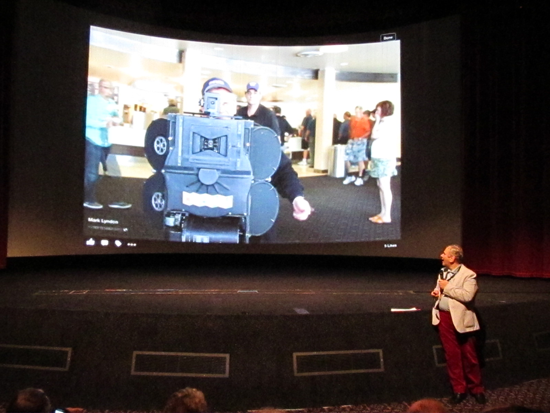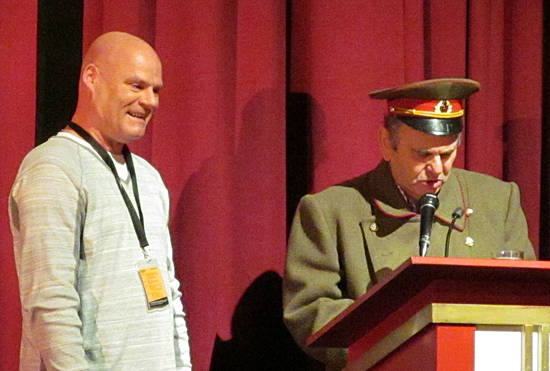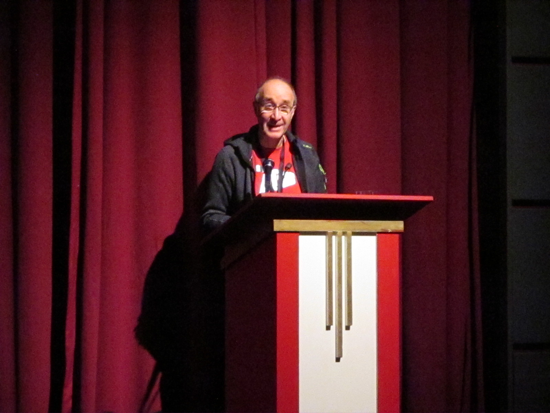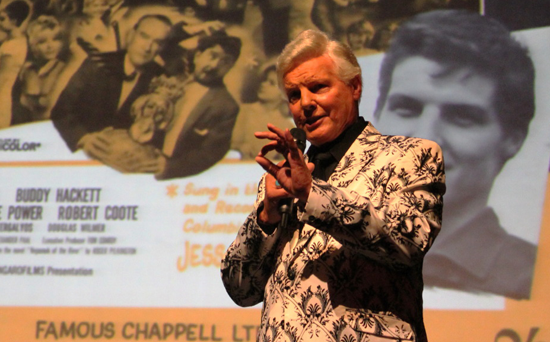Memories from Bradford |
Read more at in70mm.com The 70mm Newsletter |
| Written and photographed by: Hannemann, Lyndon, Olsson & Rostek | Date: 24.10.2016 |
Mark Lyndon's introduction to "This is Cinerama" |
|
 BKSTS
member Mark Lyndon introducing "This is Cinerama".
Picture by Anders M. Olsson. BKSTS
member Mark Lyndon introducing "This is Cinerama".
Picture by Anders M. Olsson.Hello, good morning and welcome to the Pictureville Cinema, the best cinema in the world, according to David Puttnam, no less, and home to the only genuine, three strip, 146 degree louvered screen Cinerama installation on earth. Today, we are presenting "This is Cinerama", the first and most epoch making Cinerama presentation of them all, and Cinerama is the star. What is Cinerama? The Cinerama process begins with a special, purpose built camera. One vision is captured via three 27mm Kodak Ektar lenses and registered on 35mm rolling stock housed in three separate magazines. The stock is then processed, printed and edited and finally comes together on the giant screen you see in front of you, via those three projectors behind you. The screen itself is made of 1100 strips of material like this, all facing you, thus eliminating wash out and cross reflections. Note the perforations, through which came the first true, permanently established, multi channel surround sound. Starting with this groundbreaking and epoch making production, surround sound, widescreen and colour have gradually become the way of presenting the moving image, Exceptions are rare. The resulting images and sound which you will shortly witness in "This is Cinerama" are quite breathtaking, not to mention stunning. Here is Fred Waller, the all American genius who invented Cinerama with an early prototype rig, featuring no less than 11 cameras. He also invented the gunnery trainer which was credited with saving a quarter of a million lives in World War Two. Read all about it on in70mm.com, the world's leading resource for students of all things Wide and beautiful on the giant screen! Why go to all this trouble, with such a costly, complex and clearly cumbersome way of making and exhibiting movies? When GI Johnny came marching home after World War Two was won, he intended to spend more time at home with his family, watching a brand new fangled, must have, mass produced, domestic consumer product. This was the brash new kid on the block demanding and getting all the attention. |
More in 70mm reading: Widescreen Weekend 2016 Rostek's Gallery: Wide Screen Weekend, 2016. Pictureville, Bradford Widescreen Weekend "Audience on Stage" Widescreen Weekend, Bradford, England Internet link: |
 The
Pope popped by. Picture by
Ulrich Rostek The
Pope popped by. Picture by
Ulrich RostekThis was Television! Cinema box office receipts had halved in those darkening years. It certainly didn't take an accountant from Whitehall & Marx or a Fermat to figure out the cold equations. It very much looked like movie going and hence film production was going the way of the dodo, the dinosaur and the dancing bear. Hollywood and film exhibitors were at a complete loss as to what to do about it. At this time, in Oyster Bay, on Long Island NY, a band of bold pioneers, led by Fred Waller, were working on perfecting a very different way of presenting moving pictures, one which would knock television into a cocked hat. This was Cinerama! And led by Cinerama, Cinema itself began to fight back! Many of you here this morning will be involved in the creation of show reels. What you are about to see is the daddy of them all - The Greatest Showreel Ever Sold. It sold the reason why we are all here this weekend, Widescreen! It sold the Cinerama process, it brought audiences flocking back into Cinemas. Through the sincerest form of flattery, CinemaScope and countless other imitators, it sold the idea that Cinema was still alive and kicking, still very much a viable proposition and well worth investing in and by the way a great art form... But above all, it taught the world and his partner that Cinema itself was still here and it was here to stay! Now very soon, one of the key players in the whole drama that led to the creation of this masterpiece will tell you more about it. Ladies and Gentlemen this shall be Lowell Thomas - after the overture... |
|
Vladimir Ilyich Leninerama Gold Medal |
|
 Unidentified
Russian comrade giving out the
Vladimir Ilyich Leninerama Gold Medal
award to Randich Gitschonowich (for best hair style) aka.
Randolph Gitsch!
Picture by Anders M. Olsson. Unidentified
Russian comrade giving out the
Vladimir Ilyich Leninerama Gold Medal
award to Randich Gitschonowich (for best hair style) aka.
Randolph Gitsch!
Picture by Anders M. Olsson.By unanimous decision, or else, of the Awards Committee of the Praesidium of the Supreme Soviet of the Academy of Seriously Large Format Kinematographic Systems, of the Union of Soviet Socialist Republics, it gives me great pleasure to award the highest accolade that the Academy can bestow, the Vladimir Ilyich Leninerama Gold Medal for Heroic Socialist Labour, striving in the noble cause of Cinematography by restoring and introducing great masterpiece Bing Crosby's Russian Adventure, to Comrade Randolph Gitsch! |
|
Wolfram Hannemann's introduction to „Chitty Chitty Bang Bang“ |
|
 Wolfram
introducing "Chitty". Picture by Anders M. Olsson. Wolfram
introducing "Chitty". Picture by Anders M. Olsson.What kind of film would you expect if it is presented by Albert R. Broccoli, based on a novel by Ian Fleming, with production design by Ken Adam and Peter Lamont as assistant art director, and starring - among many others - Desmond Llewelyn, better known as „Q“ and „Mr. Goldfinger“ Gert Fröbe, plus having the words „Bang Bang“ in the movie title and featuring a fancy car? A children’s musical of course! „Chitty Chitty Bang Bang“ is based on a novel by Ian Fleming which tells the story of the Pott family and their flying car by means of which they rescue a French candy maker from being held as hostage with his family by a bunch of gangsters. However, when adapting the novel for the screen Roald Dahl and director Ken Hughes came up with a completely different story as you will see. The strange country of „Vulgaria“ as well as the character of „Truly Scrumptious“ (played by Sally Ann Howes) were invented by Roald Dahl, who had provided the screenplay for the James Bond movie „You Only Live Twice“ the year before, the first Bond film to deviate severely from the original Fleming book. With a running time of approx. two hours and 20 minutes, it's one of the longest children's film in history, certainly for its time. It wouldn't be until the next millennium, with the Harry Potter films, that films for children of such length would be made again. And it was the first non-Walt Disney film to feature songs by the Sherman brothers. In addition to their music score been nominated for a Golden Globe their song „Chitty Chitty Bang Bang“ was nominated both for an Academy Award and a Golden Globe but lost it both times to Michel Legrand’s „The Windmills of your mind“ from „The Thomas Crown Affair“. The Golden Globe for Original Score went to Alex North’s „The Shoes of the Fisherman“. Dick Van Dyke was cast as Caractacus Potts after he turned down the role of Fagin from another 1968 musical „Oliver!“ (which ended up going to Ron Moody). Originally Van Dyke turned the part down but was repeatedly offered the part with more money added in each offer. When the offer reached seven figures plus a percentage of the profits, he accepted the role. In an interview during filming in October 1967 Dick Van Dyke revealed he only accepted the role of Caracatus Potts on the condition that he would not have to attempt an English accent. This was after Van Dyke's attempt at a Cockney accent in „Mary Poppins“ (1964) had been widely mocked by critics. |
|
 Jes
Conrad talking about "The Golden Head". Picture by
Ulrich Rostek Jes
Conrad talking about "The Golden Head". Picture by
Ulrich RostekHeather Ripley, who plays Jemima in the movie, recalled that she did not realize until much later that Dick Van Dyke was an alcoholic when the film was made. In addition he was smoking up to 40 cigarettes a day and found the dance numbers very demanding. Being not a professional dancer at all Van Dyke was instructed by choreographers Dee Dee Wood and Marc Breaux, who stripped down the choreography to cope with Van Dyke’s abilities. According to Van Dyke the toughest dance scene to do was the „Old Bamboo“ number. It took 23 takes for the finale of this dance, where the dancers had to jump over their bamboo sticks. And if you watch very closely you will see that Dick Van Dyke did just make it In his 2011 autobiography "Dick Van Dyke: My Lucky Life In and Out Of Show Business", Dick Van Dyke revealed that he did not get along with producer Albert R. Broccoli or director Ken Hughes during filming. According to Dick Van Dyke, director Ken Hughes hated children and Van Dyke would often have to tell him to stop cursing in front of the child actors. It was widely noted that whilst Ken Hughes was a very good 'action' director he was not good at directing actors and especially the children. Consequently it fell to Van Dyke and Sally Ann Howes to entertain the children and guide them through their performances. The part of Truly Scrumptious had originally been offered to Julie Andrews, to reunite her with Van Dyke after their success in „Mary Poppins“. Andrews rejected the role specifically because she considered that the part was too close to the Poppins mould. Instead, Sally Ann Howes was given the role. She had replaced Julie Andrews in the Broadway company of "My Fair Lady" when Andrews went to London in the musical. The Caractacus Potts inventions in the film were created by Rowland Emett; by 1976, Time magazine, describing Emett's work, said no term other than "Fantasticator...could remotely convey the diverse genius of the perky, pink-cheeked Englishman whose pixilations, in cartoon, watercolor and clanking 3-D reality, range from the celebrated Far Tottering and Oyster Creek Railway to the demented thingamabobs that made the 1968 movie „Chitty Chitty Bang Bang“ a minuscule classic. |
|
 WSW
veterans Francois Carrin and Bill Lawrence. Picture by
Ulrich Rostek WSW
veterans Francois Carrin and Bill Lawrence. Picture by
Ulrich RostekSeven different and very detailed „Chitties“ were built by production designer Ken Adam: a worn-out one, a restored one, one for the flying scenes, one for the water scenes and three partial models for various other scenes. At a 1973 auction in Florida, one of the Chitty-Chitty Bang-Bang cars sold for $37,000, equal to more than $190,000 today. The original "hero" car, in a condition described as fully functional and road-going, was offered at auction in 2011 by a California-based auction house. The car sold for $805,000, less than the $1–2 million it was expected to reach. It was purchased by New Zealand film director Sir Peter Jackson. He could be seen near the WETA Workshop in New Zealand driving cast members of „The Hobbit“ films around in the car while playing the main theme song through a sound system. Who knows, maybe we are getting a new movie, maybe „Chitty Chitty Bang Bang flies to Middle Earth“? Although most of the location filming was done in England, the scenes at Baron Bomburst’s castle were shot in Germany at Neuschwanstein, built between 1869 and 1886 for the Bavarian King Ludwig II, better known as "The Mad King of Bavaria". It is the spot not to be missed while being on holiday in Germany and it is especially popular with Japanese tourists doing their „Europe in 5 days“ tour. In addition production designer Ken Adam had part of King Ludwig’s castle built on the backlot of Pinewood Studios. To blend it in with the exterior shots of the original Neuschwanstein the Ken Adam version had to be as close to the original as possible. „Chitty Chitty Bang Bang“ was shot in 65mm Super Panavision by Christopher Challis and released in both 35mm and 70mm versions. Unfortunately no unfaded 70mm print was at hand for Widescreen Weekend and so it was decided to show a full color 35mm Dolby SR print instead which hopefully will do justice to Chris Challis‘ photography. And let me tell you that we do have someone here with us in the audience today who actually worked on this film: Tony Sloman. I am pretty sure that Tony is more than willing to share some of his memories after this screening at the bar. Director Ken Hughes, by the way, reportedly hated the finished film. Originally, my intro would have ended as follows: „And now, ladies and gentlemen, put on your safety helmets and get ready for „Chitty Chitty Bang Bang“ which will be presented in its original roadshow version (hopefully complete and uncut!), including one of the best cliffhanger intermissions – ever.“ – Well, originally. However, we found that our print is missing the intermission! I hope you will enjoy the movie nevertheless. |
|
Widescreen Weekend – A people's event by Ulrich Rostek |
|
 James
Bond screen talk with Jenny Hanley. Picture by Ulrich
Rostek James
Bond screen talk with Jenny Hanley. Picture by Ulrich
RostekAnd once again the community reunited to enjoy the whole (cinema-)scope of widescreen movies, including Cinerama (three-strip and digitally restored), 70mm, 35mm CS (black and white/MagentaVision/full color), and 4K DCP. But it's not only watching movies that makes the Widescreen Weekend. What makes the difference between WSW and similar festivals is the interactive approach (and I do not only mean virtual reality). It's the amount of people from the audience who keep the show running for the audience. It is a festival that involves people. And this is a story about people. Being well balanced WSW does not only look back to the good old days but gives a view to the future as well, starting with young film makers' approaches to wide screen cinematography. This year WSW saw a young lady's first appearance as the festival's director. Kathryn Penny (not to be confused with Miss Moneypenny) did a great job leading us through the festival and she did it in an oh so charming way. What would a classical movie be without a well presented introduction? Like all those years before the appetizing speeches prior to the movies were held by our co-delegates Sir Christopher Frayling („The Agony and the Ecstasy“), Tony Sloman („The Innocents“), and Wolfram Hannemann („Chitty Chitty Bang Bang“), to mention a few. |
|
 The
audience. Picture by Ulrich
Rostek The
audience. Picture by Ulrich
RostekOnce again our long time usual suspects David Strohmaier and Randy Gitsch brought their latest Cinerama restauration „Cinerama's Russian Adventure“. Restored from original three strip elements it looked really great. So another piece of motion picture history is saved before the last surviving 35-mm-prints turn to vinegar. We are all looking forward to seeing the new restorations of „This is Cinerama“ and „Windjammer“ which the two guys are preparing from three strip elements as well. Furthermore the two presented their digital restoration of the Technirama children's detective story „The Golden Head“ - and gave the audience the chance to welcome 80 years young singer/actor/entertainer Jess Conrad, who played a leading role in that film and told about his experiences in a screen talk with Dave. Like Alec Guinness once in „Kind Hearts and Coronets“, long time delegate and fellow Mark Lyndon had a multiple role appearance this year. Being dressed up as the pope – a tribute to pope Julius in the opening film „The Agony and the Ecstasy“ - he was the eyecatcher of the reception party on Thursday. Changing the pope's robe to a Russian military uniform, he honored Randy Gitsch for his outstanding contribution to the cultural heritage of the Russian people by remastering „Cinerama's Russian Adventure“. After playing himself introducing „This is Cinerama“ he was seen in a white tuxedo and with a heavy weight drink in his hands – shaken, not stirred. Luckily he did not dress up for „Aliens“. Before the festival ended with a high quality 4K DCP of the James Bond movie „On her Majesty's Secret Service“ screen talk guest Jenny Hanley, who played one of the Bond Girls, gave an interesting view behind the scenes. And as at the end of the last reel James Bond was announced to return to the screen so are we delegates looking forward to our reunion in 2017 at Pictureville. Does this article too much look like a family's story? You are pretty well right, this IS a family's story! Come and join the next WSW, come and be part of the community. But watch out, the first shot makes you addicted for the rest of your life. • Go to the gallery: Wide Screen Weekend, 2016. Pictureville, Bradford |
|
| Go: back - top - back issues - news index Updated 22-01-25 |
